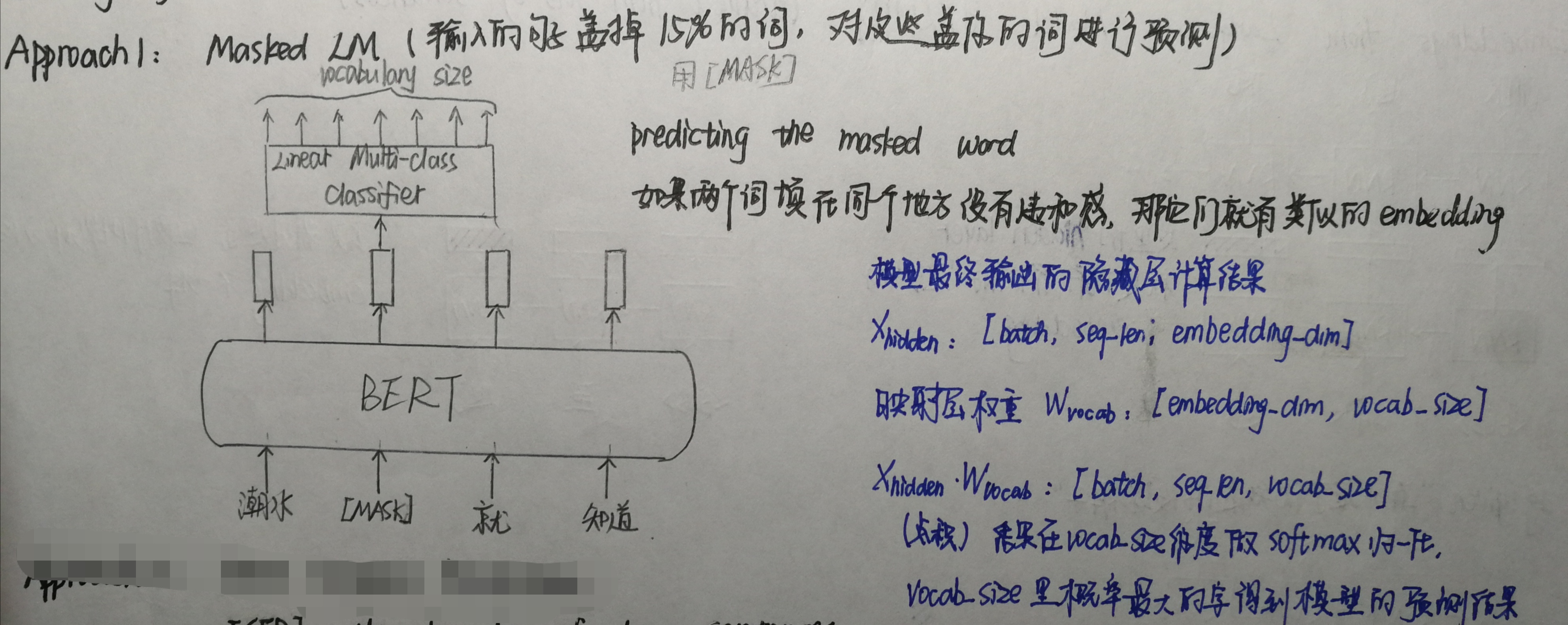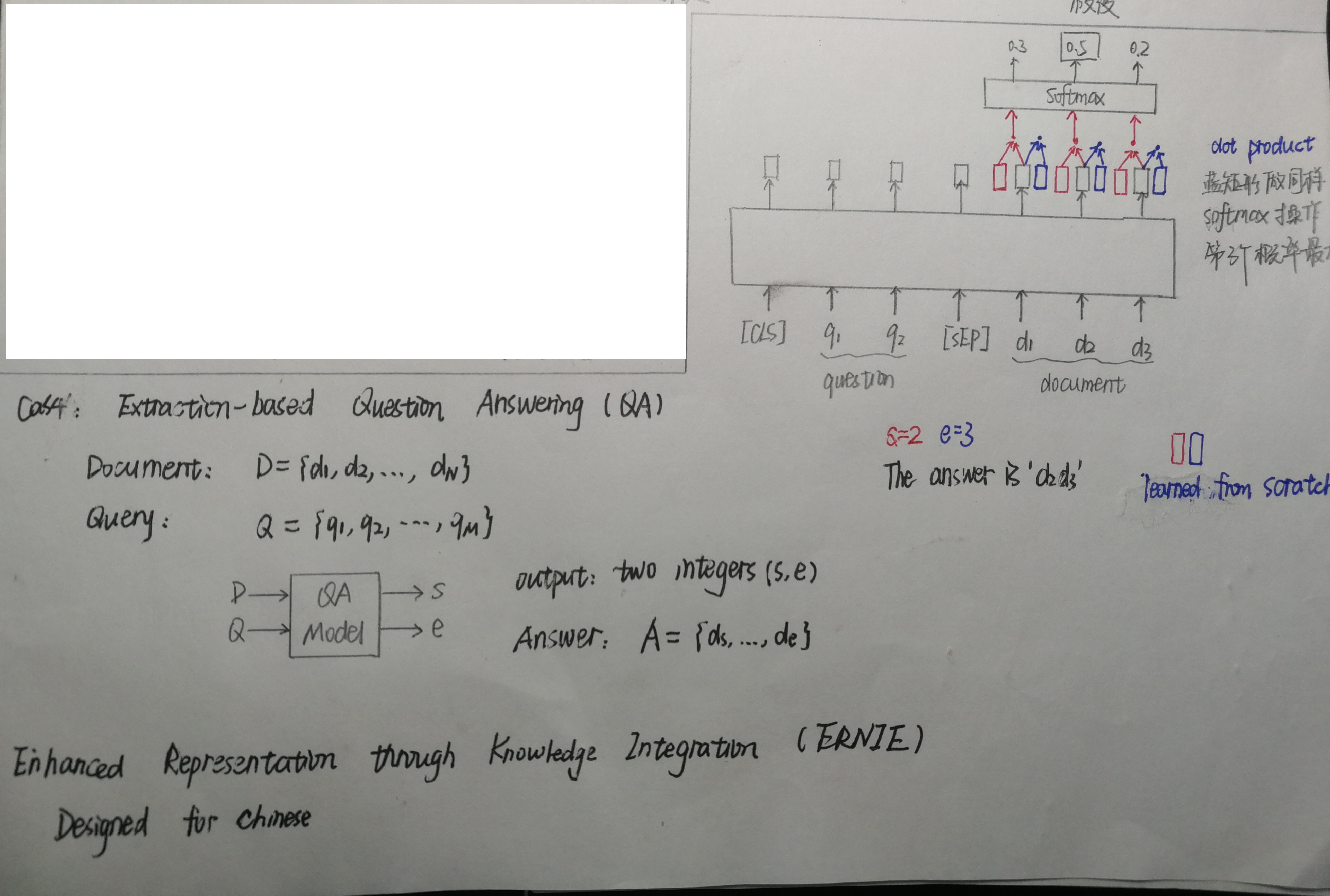1. transformer资料
transformers(以前称为pytorch-transformers和pytorch-pretrained-bert)
-
提供用于自然语言理解(NLU)和自然语言生成(NLG)的BERT家族通用结构(BERT,GPT-2,RoBERTa,XLM,DistilBert,XLNet等),包含超过32种、涵盖100多种语言的预训练模型。
-
首先下载transformers包,
pip install transformers -
其次手动下载模型(直接
from transformers import BertModel会从官方的s3数据库下载模型配置、参数等信息,在国内并不可用)- 下载bert-base-chinese的config.josn,vocab.txt,pytorch_model.bin三个文件后,放在bert-base-chinese文件夹下,此例中该文件夹放在
F:/Transformer-Bert/下。
- 下载bert-base-chinese的config.josn,vocab.txt,pytorch_model.bin三个文件后,放在bert-base-chinese文件夹下,此例中该文件夹放在
提前导包:
import numpy as np
import torch
from transformers import BertTokenizer, BertConfig, BertForMaskedLM, BertForNextSentencePrediction
from transformers import BertModel
model_name = 'bert-base-chinese'
MODEL_PATH = 'F:/Transformer-Bert/bert-base-chinese/'
# a. 通过词典导入分词器
tokenizer = BertTokenizer.from_pretrained(model_name)
# b. 导入配置文件
model_config = BertConfig.from_pretrained(model_name)
# 修改配置
model_config.output_hidden_states = True
model_config.output_attentions = True
# 通过配置和路径导入模型
bert_model = BertModel.from_pretrained(MODEL_PATH, config = model_config)
利用分词器进行编码:
-
encode仅返回input_ids
-
encode_plus返回所有编码信息
-
input_ids:是单词在词典中的编码 -
token_type_ids:区分两个句子的编码(上句全为0,下句全为1) -
attention_mask:指定 对哪些词 进行self-Attention操作
-
print(tokenizer.encode('吾儿莫慌')) # [101, 1434, 1036, 5811, 2707, 102]
sen_code = tokenizer.encode_plus('这个故事没有终点', "正如星空没有彼岸")
# print(sen_code)
# [101, 1434, 1036, 5811, 2707, 102]
# {'input_ids': [101, 6821, 702, 3125, 752, 3766, 3300, 5303, 4157, 102, 3633, 1963, 3215, 4958, 3766, 3300, 2516, 2279, 102],
# 'token_type_ids': [0, 0, 0, 0, 0, 0, 0, 0, 0, 0, 1, 1, 1, 1, 1, 1, 1, 1, 1],
# 'attention_mask': [1, 1, 1, 1, 1, 1, 1, 1, 1, 1, 1, 1, 1, 1, 1, 1, 1, 1, 1]}
将input_ids转化回token:
print(tokenizer.convert_ids_to_tokens(sen_code['input_ids']))
# ['[CLS]', '这', '个', '故', '事', '没', '有', '终', '点', '[SEP]', '正', '如', '星', '空', '没', '有', '彼', '岸', '[SEP]']
将分词输入模型,得到编码:
# 对编码进行转换,以便输入Tensor
tokens_tensor = torch.tensor([sen_code['input_ids']]) # 添加batch维度并,转换为tensor,torch.Size([1, 19])
segments_tensors = torch.tensor(sen_code['token_type_ids']) # torch.Size([19])
bert_model.eval()
# 进行编码
with torch.no_grad():
outputs = bert_model(tokens_tensor, token_type_ids = segments_tensors)
encoded_layers = outputs # outputs类型为tuple
print(encoded_layers[0].shape, encoded_layers[1].shape,
encoded_layers[2][0].shape, encoded_layers[3][0].shape)
# torch.Size([1, 19, 768]) torch.Size([1, 768])
# torch.Size([1, 19, 768]) torch.Size([1, 12, 19, 19])
Bert最终输出的结果维度为:sequence_output, pooled_output, (hidden_states), (attentions)
以输入序列为19为例:
-
sequence_output:torch.Size([1, 19, 768])
- 输出序列
-
pooled_output:torch.Size([1, 768])
- 对输出序列进行pool操作的结果
-
(hidden_states):tuple, 13 * torch.Size([1, 19, 768])
- 隐藏层状态(包括Embedding层),取决于 model_config 中的 output_hidden_states
-
(attentions):tuple, 12 * torch.Size([1, 12, 19, 19])
- 注意力层,取决于
model_config中的output_attentions
- 注意力层,取决于
2. 遮蔽语言模型 Masked Language Model
BERT以训练遮蔽语言模型(Masked Language Model)作为预训练目标。
-
具体来说就是把 输入的语句中的字词 随机用 [MASK] 标签覆盖,然后 训练模型 结合被覆盖的词的 左侧 和 右侧上下文进行预测。
-
可以看出,BERT 的做法 与 从左向右语言模型只通过左侧语句预测下一个词的做法相比,遮蔽语言模型 能够生成同时融合了左、右上下文的语言表示。
-
这种做法能够使 BERT 学到字词更完整的语义表示。

model_name = 'bert-base-chinese' # 指定需下载的预训练模型参数
# 任务一:遮蔽语言模型
# BERT 在预训练中引入 [CLS] 和 [SEP] 标记句子的 开头和结尾
samples = ['[CLS] 中国的首都是哪里? [SEP] 北京是 [MASK] 国的首都。 [SEP]'] # 准备输入模型的语句
tokenizer = BertTokenizer.from_pretrained(model_name)
tokenizer_text = [tokenizer.tokenize(i) for i in samples] # 将句子分割成一个个token,即一个个汉字和分隔符
# [['[CLS]', '中', '国', '的', '首', '都', '是', '哪', '里', '?', '[SEP]', '北', '京', '是', '[MASK]', '国', '的', '首', '都', '。', '[SEP]']]
# print(tokenizer_text)
input_ids = [tokenizer.convert_tokens_to_ids(i) for i in tokenizer_text]
input_ids = torch.LongTensor(input_ids)
# print(input_ids)
# tensor([[ 101, 704, 1744, 4638, 7674, 6963, 3221, 1525, 7027, 8043, 102, 1266,
# 776, 3221, 103, 1744, 4638, 7674, 6963, 511, 102]])
# 读取预训练模型
model = BertForMaskedLM.from_pretrained(model_name, cache_dir = 'F:/Transformer-Bert/')
model.eval()
outputs = model(input_ids)
prediction_scores = outputs[0] # prediction_scores.shape=torch.Size([1, 21, 21128])
sample = prediction_scores[0].detach().numpy() # (21, 21128)
# 21为序列长度,pred代表每个位置最大概率的字符索引
pred = np.argmax(sample, axis=1) # (21,)
# [',', '中', '国', '的', '首', '都', '是', '哪', '里', '?', '。', '北', '京', '是', '中', '国', '的', '首', '都', '。', '。']
print(tokenizer.convert_ids_to_tokens(pred))
print(tokenizer.convert_ids_to_tokens(pred)[14]) # 被标记的[MASK]是第14个位置, 中
3. 句子预测任务
-
预训练 BERT 时除了 MLM 预训练策略,还要进行预测下一个句子的任务。
-
句子预测任务基于理解两个句子间的关系,这种关系无法直接被 Masked Language Model 捕捉到。

# sen_code1 = tokenizer.encode_plus('今天天气怎么样?', '今天天气很好!')
# sen_code2 = tokenizer.encode_plus('明明是我先来的!', '我喜欢吃西瓜!')
# tokens_tensor = torch.tensor([sen_code1['input_ids'], sen_code2['input_ids']])
# print(tokens_tensor)
# tensor([[ 101, 791, 1921, 1921, 3698, 2582, 720, 3416, 102, 791, 1921, 1921,
# 3698, 2523, 1962, 102],
# [ 101, 3209, 3209, 3221, 2769, 1044, 3341, 4638, 102, 7471, 3449, 679,
# 1963, 1921, 7360, 102]])
# 上面可以换成
samples = ["[CLS]天气真的好啊![SEP]一起出去玩吧![SEP]", "[CLS]小明今年几岁了[SEP]我不喜欢学习![SEP]"]
tokenizer = BertTokenizer.from_pretrained(model_name)
tokenized_text = [tokenizer.tokenize(i) for i in samples]
input_ids = [tokenizer.convert_tokens_to_ids(i) for i in tokenized_text]
tokens_tensor = torch.LongTensor(input_ids)
# 读取预训练模型
model = BertForNextSentencePrediction.from_pretrained(model_name, cache_dir='F:/Transformer-Bert/')
model.eval()
outputs = model(tokens_tensor)
# sequence_output:输出序列
seq_relationship_scores = outputs[0] # seq_relationship_scores.shape: torch.Size([2, 2])
sample = seq_relationship_scores.detach().numpy() # sample.shape: [2, 2]
pred = np.argmax(sample, axis=1)
print(pred) # [0 0], 0表示是上下句关系,1表示不是上下句关系
4. 问答任务

任务输入:问题句“里昂是谁”,答案所在文章“里昂是一个杀手”
任务输出:一对整数,表示答案在文本中的开头和结束位置
model_name = 'bert-base-chinese'
# 通过词典导入分词器
tokenizer = BertTokenizer.from_pretrained(model_name)
# 导入配置文件
model_config = BertConfig.from_pretrained(model_name)
# 最终有两个输出,初始位置和结束位置
model_config.num_labels = 2
# 根据bert的 model_config 新建 BertForQuestionAnsering
model = BertForQuestionAnswering(model_config)
model.eval()
question, text = '里昂是谁?', '里昂是一个杀手。'
sen_code = tokenizer.encode_plus(question, text)
tokens_tensor = torch.tensor([sen_code['input_ids']])
segments_tensors = torch.tensor([sen_code['token_type_ids']]) # 区分两个句子的编码(上句全为0,下句全为1)
start_pos, end_pos = model(tokens_tensor, token_type_ids = segments_tensors)
# 进行逆编码,得到原始的token
all_tokens = tokenizer.convert_ids_to_tokens(sen_code['input_ids'])
print(all_tokens) # ['[CLS]', '里', '昂', '是', '谁', '[SEP]', '里', '昂', '是', '一', '个', '杀', '手', '[SEP]']
# 对输出的答案进行解码的过程
answer = ' '.join(all_tokens[torch.argmax(start_pos) : torch.argmax(end_pos) + 1])
# 每次执行的结果不一致,这里因为没有经过微调,所以效果不是很好,输出结果不佳,下面的输出是其中的一种。
print(answer) # 一 个 杀 手